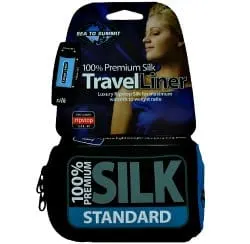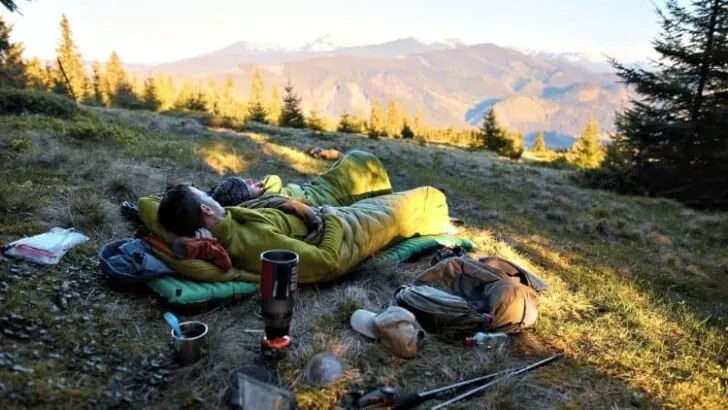It’s a cold fall night and you’re tucked into your summer sleeping bag, wishing you had extra layers to keep you warm. Unfortunately, your 35-degree bag just isn’t going to cut it, but you don’t want to invest in a warmer sleeping bag for shoulder-season adventures. A friend told you that a sleeping bag liner would solve your problems on those cold nights, but you’re not convinced.
Should you use a sleeping bag liner? Absolutely. Sleeping bag liners are some of the most versatile pieces of camping gear out there and they can substantially extend the functional temperature range of your sleeping bag with minimal added weight and cost. Plus, they can help you stay cool on warm nights and are great for keeping your sleeping bag clean on longer camping trips.
We understand that if you’re new to the world of sleeping bag liners, though, you might not know where to start when it comes to choosing the right model for your needs. So, to get you started off on the right foot, we’ve put together a guide to all the information you need to find the perfect sleeping bag liner for your next adventure.
How to Choose a Sleeping Bag Liner:
First things first, how does one choose a sleeping bag liner? Since there are so many different makes and models on the market today, it’s easy to be overwhelmed. To make things easier for yourself, here are the things you should look out for when shopping around…
1. Know the types of sleeping bag liners
There are a number of different types of sleeping bag liners out there, each with its own specific use. Here are the main options available to you:
Cold weather
Cold weather sleeping bag liners are designed to extend the useable temperature range of your sleeping bag. They are generally made from fleece or some sort of Thermolite or Primaloft insulation, which helps trap in extra heat for a better night’s sleep.
Generally, these sleeping bag liners are sold with a temperature rating, which tells you approximately how much warmer they’ll make your sleeping bag. So, if you have a 35 degree Fahrenheit bag that you’d like to use for cold fall camping, you might opt for a liner that can give you an extra 20 degrees of warmth for those frosty nights.
Warm weather
Unlike cold weather liners, warm weather sleeping bag liners are meant to be used in particularly hot and humid nights. For the most part, these liners are made from silk, cotton, or merino wool and are designed to wick moisture away from your body to help cool you down. They offer minimal, if any insulating value, which makes them perfect for summer camping.
Travel
Finally, we have travel-specific models, which are unique in the world of sleeping bag liners. Travel liners are designed specifically for people who spend a lot of time staying in hostels, which may have questionable standards of cleanliness.
For the most part, these liners are made from cotton or silk and are designed to be a little sleeping cocoon that separates you from the mattress and sheets in your hostel. Travel liners are also popular amongst hut-to-hut hikers and skiers who don’t want to sleep directly on a bed that dozens of other sweaty hikers have slept in before them.
2. Know your sleeping bag liner material options
Modern sleeping bag liners come in a lot of different materials, each of which has its own advantages and disadvantages. Here are the most popular options:
Fleece
Fleece liners are warm and cozy, thanks to their plush fabric. This material is generally found in cold weather liners because of its insulating value. However, while it is often an affordable material, fleece is heavy and bulky when compared to other options.
Cotton
Cotton is an affordable fabric that’s used in everything from t-shirts to towels. When used in sleeping bag liners, cotton is used to wick away moisture and keep campers cool on warm nights. That being said, it is quite heavy and bulky for backcountry use so it is generally best for travelers.
Silk
Silk is one of the most expensive materials around but is amazing at wicking away sweat and keeping people cool in the hottest, most humid conditions. It’s also incredibly lightweight and comfortable against the skin, which makes it ideal for frequent use.
Wool
Most wool-based sleeping bag liners are made with merino wool, which is a good insulator that also wicks away sweat. It’s generally quite expensive, though not as much as silk alternatives. However, it is slightly heavier and bulkier than silk liners.
Thermolite
Thermolite is a type of synthetic insulation that is found in a variety of different outdoor products. In sleeping bag liners, it’s used to add insulation and warmth to your sleeping bag on cold nights. While it’s not particularly expensive, if you’re looking to add more than 10 or 15 degrees of warmth to your bag, thermolite can be quite a bulky option.
Primaloft
Primaloft is another type of insulation that’s often found in synthetic puffy jackets. It’s a bit more expensive than thermolite but offers a better warmth-to-weight ratio, which is ideal for particularly cold nights.
3. Consider the added weight
No one likes carrying around extra weight in their pack, so finding a relatively lightweight sleeping bag liner is ideal. As we’ve mentioned, certain materials generally weigh more than others, so if you’re looking to keep your pack weight down, silk, Primaloft, and merino wool are probably your best options.
4. Know your potential weather conditions
Every sleeping bag liner is designed for specific weather conditions, so it’s important to know what you’re getting into before you buy. For the most part, fleece, thermolite, and Primaloft models are best used in cold weather conditions, perhaps during the late fall and early spring. They can also be used to some extent in the winter if you just need a little bit of extra warmth in your 0 degree sleeping bag.
Alternatively, silk, cotton, and merino wool are best used in the warmer summer months where your main concern is staying cool in the heat. However, do keep in mind that cotton is not a great option for backcountry use since it can actually make you colder if it gets wet. Thus, cotton is best used just in travel-specific liners.
5. Understand the liner’s ease of use
The ease of use of a sleeping bag liner comes from two main factors: spaciousness and packability.
First and foremost, if a sleeping bag liner is too tight and constricting, it’s going to be uncomfortable to sleep in. While you’re already constrained by the width of your sleeping bag, there’s no reason to be even more restricted by your sleeping bag liner. Thus, wider liners tend to be easier to use.
Finally, no one likes spending hours trying to pack their gear away in the morning, so if your sleeping bag liner is annoying to pack away, it’s not going to be very fun to use. Silk liners tend to be the easiest to pack, since they’re so small and compact, while bulky fleece can be a bit of a challenge.
Popular Sleeping Bag Liner Brands
There are many different sleeping bag liners out there, so you want to be sure you’re buying from a trusted brand. These are some of the most popular brands out there, each with their own great reputation:
Nemo Equipment
Nemo Equipment is a New Hampshire-based gear manufacturer that creates some of the most innovative products in the outdoor industry. While they’re best known for their line of unique tents, their sleeping bags, sleeping pads, and sleeping bag liners are becoming more and more popular every year.
More info: nemoequipment.com
Sea to Summit
Sea to Summit started in Australia in the 1990s when mountaineer Tim Maccartney-Snape approached gear maker Roland Tyson for help with creating equipment that would work well for his upcoming trip to climb Mount Everest – starting at sea level.
These days, Sea to Summit makes a wide range of different gear for both outdoor and travel pursuits. Their sleeping bag liners are some of the most popular on the market today and come in nearly every material you can imagine.
More info: seatosummitusa.com
The Friendly Swede
The Friendly Swede is a Swedish-based company that makes products inspired by the active Swedish lifestyle. Simple, yet functional, they create gear that looks as good as it works. They’re well known for making one very popular model of sleeping bag liner that comes either in a smooth fleece microfiber or a silky polyester fabric.
More info: thefriendlyswede.com
How to Make Your Own “DIY” Sleeping Bag Liner
Since sleeping bag liners are basically just sack-shaped pieces of fabric, you might be wondering if you can make one at home. The answer? Sure, with fabric, a sewing machine, and a sense of creativity, it’s certainly popular to make a DIY sleeping bag liner. Here’s how:
- Choose a liner fabric that is best for your camping needs. Buy at least 2 yards of it, or perhaps more if you’re quite tall.
- Get some packing paper and lay it out on the floor. Take your sleeping bag and place it on top of the packing paper. Trace an outline of your zipped-up sleeping bag onto the paper. Don’t include the hood, unless you want to be adventurous and make a hood for your liner.
- Remove the sleeping bag and paper from the floor. Place your doubled-over fabric on the ground and cover it with the packing paper. Pin the paper in place onto the fabric with the edge of the paper flush with the folded edge of the fabric.
- Cut along the traced pattern on the open sides of the fabric (not the folded edge!).
- Take the cut fabric and unfold it. Orient it so the exterior part of the fabric (the stuff you don’t want against your skin) is on the outside.
- Sew the bottom of the liner and 3/4 of the open side. Flip inside out and, voila! You have a sleeping bag liner.
My Liner Recommendations:
Sea to Summit Adaptor Coolmax (Best Warm Weather Liner)

The Sea to Summit Adaptor Coolmax is made to help keep you cool on warm weather adventures. This liner features Coolmax fabric, which is specifically designed to help wick away moisture while staying cool and comfortable during hot, humid nights in the backcountry.
Sea to Summit Reactor Extreme (Best Cold Weather Liner)

With the ability to add up to 25 degrees Fahrenheit (14 degrees Celsius) to your sleeping bag’s temperature rating, the Sea to Summit Reactor Extreme is the perfect companion on cold-weather adventures. It’s a great way to extend the useable range of your three-season sleeping bag into the colder months of the year.
Sea to Summit Silk (Best Travel Liner)

The Sea to Summit Silk Travel Liner is a compact, machine washable sleeping bag liner perfect for globetrotters. Lightweight, yet comfortable, it’s a great addition to any travel packing list.
Up Next In Backpacking Gear:
Are Quilts Better than Sleeping Bags? (Backpacking FAQs)
Do You Need a Sleeping Pad for Backpacking?
How To Stay Warm Camping in Cold Weather: 18 Tips and Tricks
Women’s Ultralight Backpacking Gear List: 9 lb Base Weight

David is an accomplished mountain endurance athlete who has completed over 25 ultra marathon races (follow on Strava). He is most proud of his finish at The Drift 100 – a high elevation, 100 mile winter foot race that zigzags along the Continental Divide in Wyoming. In the future he hopes to compete in the ITI 350 and ultimately the full 1,000 mile Iditarod Trail Invitational that follows the same path as the historic dog sled race.


Leave a comment
You must be logged in to post a comment.